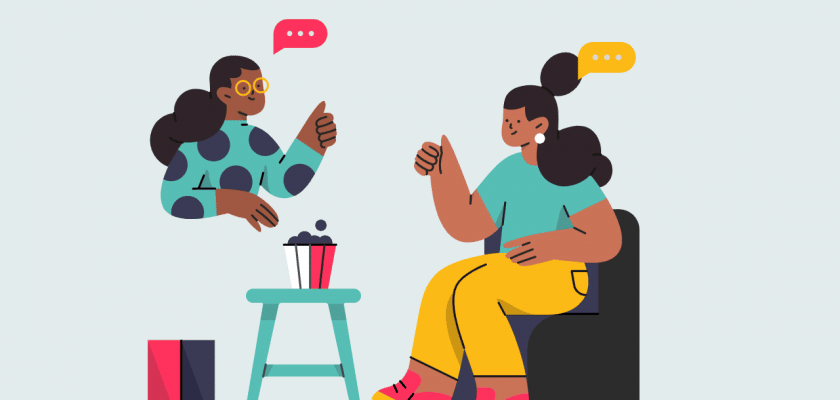One of the greatest challenges facing educators today is learning how to keep a student’s interest while still providing the most rigorous curriculum possible to make students read and help them achieve success. There are a number of different types of read-aloud programs that can help teachers and education professionals motivate primary students but is Popcorn Reading one of them?
Table of Contents
- What Is Popcorn Reading?
- A Brief History Of Popcorn Type Reading
- Proposed Popcorn Reading Benefits
- Is Round Robin Reading The Same As Popcorn Reading?
- Advantages Of Round Robin Reading
- Popcorn Reading And Struggling Readers
- Popcorn Reading FAQs
- Summary
What Is Popcorn Reading?

Popcorn reading or combat reading as it’s sometimes called is a technique whereby strong and weak readers are asked to read aloud for a period of time and then say, “Popcorn,” and choose other students to read or respond to the text. Unlike Round Robin reading, students cannot predict when they are likely to be called on. Therefore, it is much harder for them to tell when their turn silent reading is coming up.
It’s good to have a number of alternatives to this type of reading strategy before implementing it as part of your reading process. Do your own research on the popcorn reading technique and decide what you think.
A Brief History Of Popcorn Type Reading
Popcorn reading or combat reading began when academia started to shift from the teacher being the “sage on the stage” to their role as a “guide on the side.” According to The Language Arts Journal of Michigan, the idea of reflective practice reading emerged as an important aspect of reading education when it was noted that not enough attention was given to the technique in which students were taught to read.
If you read the entire article on this reading technique, however, you start to see that, while it is important to create reflective reading in an environment that inspires kids to be alert and ready, this technique often was unable to achieve this. (The Language Arts Journal of Michigan, Vol. 26, Issue 2)
Some educators report some success with this approach, but it is rare that it achieves what the education community hopes it will achieve.

Proposed Popcorn Reading Benefits
The popcorn reading strategy, a prevalent classroom method, is tailored to enhance student engagement, focus, and involvement during group reading activities, which can sometimes become tedious due to the round-robin style. By integrating the element of unpredictability and engaging all students in the reading process, popcorn-guided reading also presents several crucial benefits:
- Elevated Focus:
Popcorn reading inspires students to remain attentive to the text since they may be asked to read aloud without warning. This increased focus helps students evade the awkwardness of being caught unprepared and contributes to a more concentrated learning atmosphere.
- Unexpectedness:
Integrating an element of surprise into the reading activity generates excitement, as students cannot predict when they will be called upon to read aloud. This unexpectedness heightens interest and persuades students to stay involved throughout the reading session.
- Collaborative Involvement:
The popcorn reading strategy encourages a sense of teamwork in the classroom by engaging all students in oral reading exercises. Active involvement in other oral reading activities not only refines reading skills but also improves comprehension and retention of the content being read. Moreover, it enables the teacher to evaluate each student’s reading competence and pinpoint areas that might need additional assistance.
- Development of Listening Skills:
As students eagerly await their turn to read aloud, they must also listen attentively to their classmates. This process nurtures active listening skills, which are crucial for efficient communication and comprehension of the material being covered.
- Embracing Diversity:
Popcorn reading fosters a more inclusive classroom environment, as it offers chances for students with different reading abilities to participate in the activity. This welcoming atmosphere nurtures a sense of belonging and helps students gain confidence in their reading capabilities.
In summary, the popcorn reading strategy presents various benefits that cultivate an engaging and focused classroom setting. By incorporating aspects of surprise, active participation, and inclusiveness, this approach refines students’ reading and listening abilities while fostering a favorable learning environment.
Is Round Robin Reading The Same As Popcorn Reading?
Round Robin reading has been used even longer than its successor. We can all remember back in the 1960s experiencing “Round Robin” reading in our elementary classrooms. Round Robin Reading involves going around in a pattern such as all the way around a table so that students take turns reading aloud one at a time. When it is their turn, they read the designated passage aloud and might be asked to comment on it afterward.

It is not the same as round-robin reading, but it resembles it to the casual observer since it also involves all students be involved when it is their turn. Here’s a look at a video featuring a book called The Popcorn Book that emphasizes this process in a metaphorical fashion.
Advantages Of Round Robin Reading
The advantage to kids with this kind of plan is that they know when their turn is coming up, providing them more time to prepare for their reading turn mentally. This is good because it helps poor readers to relax while waiting on their turn but, because they can predict when their time is coming up, they can literally just prepare for their passage and then completely “turn off” for the rest of the reading. This can lower performance results and contribute to overall student achievement.
This is partly why Round Robin reading was replaced with other similar types of techniques that were more likely to lead to students’ higher reading ability by challenging kids to always be aware and alert and to understand everyone’s passages, rather than just their own.
Popcorn Reading And Struggling Readers
The popcorn reading approach has sparked debate due to concerns about its possible adverse effects on specific students, particularly those who are introverted, are poor readers or have special education requirements. The primary concern is that it may embarrass these students and inadvertently contribute to their diminished reading confidence.
A significant disadvantage of popcorn reading is that it can cause students who are shy, introverted, or have special education needs to feel overwhelmed or anxious. This discomfort arises because they don’t have the chance to prepare or practice the portion they’ll be asked to read aloud since their turn is entirely unexpected. As a result, these students might experience additional stress when participating in the activity, which could heighten their anxiety and further diminish their self-confidence.
Additionally, the popcorn reading technique might not effectively cater to the varied learning needs of all students. While it can stimulate attentiveness and engagement in oral reading for some, it may also create an environment where students with learning disabilities or slower reading speeds are at a disadvantage. The fear of embarrassment, combined with the lack of preparation, may deter these students from participating in class and impede their overall academic development.

In addition to the potential negative effects on students’ confidence and learning experiences, critics argue that popcorn reading doesn’t promote the development of essential reading skills like fluency, comprehension, and critical thinking. When students are primarily concerned with avoiding embarrassment, their ability to absorb and understand the material being read might be compromised.
Despite the potential drawbacks, supporters of popcorn reading argue that the method can be effective in encouraging classroom engagement and maintaining students’ attention during group reading activities. However, it is crucial for teachers to consider the unique needs and abilities of their students when implementing this approach, ensuring that it is a positive learning experience for everyone involved.10 Alternatives for Struggling Readers.
There are quite a few viable alternatives to this type of reading instruction. Below are 10 alternatives that educators and reading instructors may want to try out in their own classrooms as school begins this year.
Finding effective approaches to support students who struggle with reading can be difficult for teachers and reading instructors. As the new school year approaches, consider implementing these 10 alternative techniques to help improve reading skills and boost students’ and struggling readers’ confidence in the classroom.
- Choral Reading Or Oral Reading
Choral reading, or recitation, is a cooperative technique where the entire class reads a passage aloud together, hence the name choral reading as it’s similar to a chorus in a theatrical play. The Choral reading method actively involves all students in the reading process but might not delve deeply enough into the development of specific and essential reading skills. It can, however, be a great way to introduce new material and foster a sense of unity within the classroom.
- Detailed Reading
Detailed reading involves an intensive examination of a passage from a book or other text. This method places a greater emphasis on text-based vocabulary instruction, comprehension strategies, and fluency-oriented reading instruction. Through detailed reading, students can analyze the text more thoroughly, which helps them better understand the material and develop a deeper appreciation for the written word.
- Interactive Reading
Interactive reading encourages students to engage with the text on a deeper level, significantly improving their comprehension skills. This approach often includes a focus on vocabulary, timing, and expressive reading. By analyzing the text more profoundly, students can extract deeper meaning and insight. Interactive reading is particularly beneficial for younger children and aural learners, as it helps to maintain their interest and attention.

- Reflective Reading
Reflective reading is a unique approach that features teachers reading a line of text aloud, followed by students reflecting it back using their own words and gestures. This reflective practice method encourages students to focus on their own interpretation of the text, allowing for a more personalized and immersive reading experience.
- Challenge Reading
Challenge reading, also known as “word wars,” is a controversial technique in which classmates select a student whom they believe is not paying attention and ask them to read or comment. While this method can create a sense of urgency and motivate students to stay engaged, it can also exacerbate issues inherent in popcorn reading and generate friction among classmates.
- Tap And Read
In Tap and Read, the instructor gently taps a student to signal it’s their turn to read and then taps another student to read when it’s time for them to take over. By removing the responsibility of students selecting readers, this technique helps alleviate the fear and anxiety often experienced by struggling readers, as the teacher is mindful not to embarrass anyone.
- Stick Drawing Reading
Stick Drawing Reading involves writing the names of all students on sticks and placing them in a container. The teacher then selects two-person student teams for the next reader by drawing a stick from the container. This random selection process keeps students engaged and encourages them to be prepared to read at any moment.
- Partner Reading
Partner reading is an effective technique that fosters collaboration and support among peers. Partner reading promotes reading together in a comfortable, non-threatening environment, students can learn from one another and develop their reading skills in a more relaxed setting.
- Buddy Reading
Buddy reading is a fast-growing strategy that pairs proficient readers with those who need extra help. This approach not only helps to improve the reading skills of both students but also fosters a helpful, cooperative learning environment rather than a competitive one.
- Crazy Professor Reading Game
The Crazy Professor Reading Game is a fun and lively technique that incorporates elements of dramatic play and improvisation. By allowing students to engage in creative role-play while reading, this method helps maintain their interest and promotes increased achievement levels. It’s an excellent way to make reading an enjoyable, interactive experience for all students.
Popcorn Reading FAQs
Sure. You can always gain insight from old methods of instruction but don’t use the entire program. Instead, take the best parts and customize them to best fit the needs of your students.
This is a fun game where the teacher reads aloud with wild enthusiasm to get kids into “dramatic play mode,” then passes the opportunity to others who serve as other actors in the “drama.”
Work on improving reading comprehension, and poor fluency skills, demonstrate comprehension strategies and application to the real world and writing.
Include all students, but do it in such a way as to make all students feel successful.
Summary
While some good can be gained from using tried-and-true old methods such as Popcorn and Round Robin reading programs, the most beneficial aspect of both techniques are the level of engagement students tend to experience in these methods. Other than that, a graduate research paper claimed that they hold a very little benefit in boosting student reading or overall comprehensive ability or improving student fluency either. What is needed in a complete makeover with your program that will reveal what is needed specifically for your students to help them learn independently as well as with peer groups in the class environment. Every class is different. Every student is different with different needs for reading achievement. Analyze your methods and think about how you can engage students while still striving to raise the bar for struggling and higher-achieving readers.
